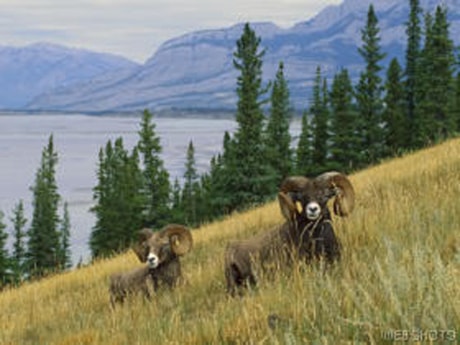Every summer south of Nordegg, some bighorn sheep wrestling is done in the name of research.
At the remote Ram Mountain research site, which is located an hour’s drive from Hwy 11 by car — and when the road ends, by quad — graduate university students man-handle sheep caught in a corral in order to record their vital measurements.
In the course of sizing up various rams’ horns and heights for ongoing research projects at the site since the early 1970s, the students began noticing that certain animals always put up a fierce fight, while others went with the flow and were more compliant.
This eventually led to an offshoot research project on the personality of rams. The results were recently published in the Journal of Evolutionary Biology.
David Coltman, a professor of biology at the University of Alberta, said the researchers not only found that some personality traits — whether boldness or docility — were specific to certain rams. They also found these same traits were inherited by the ram’s offspring.
As well, the researchers discovered that aggressive, bold rams sired a lot of lambs when they were young, but tended to die early.
More passive rams generally lived longer, sired more lambs later in life, and often achieved a higher social ranking in the herd.
Coltman believes some of the personality findings about rams can be applied to people. “There are different temperaments, but you’ve heard the saying, the apple doesn’t fall far from the tree?”
The Ram River research site was first opened by Alberta Fish and Wildlife staff almost 40 years ago to conduct population studies of bighorn sheep. Researchers have monitored natural population swings as well as recorded what happened when a number of ewes were relocated.
Jon Jorgenson. senior Fish and Wildlife biologist for Alberta Sustainable Resource Development in Camrose, said many helpful conclusions were drawn over the years. For instance, the optimum population for bighorn sheep in the Ram Mountain area was found to be about 100 animals. At that number, the sheep were large and healthy, said Jorgenson. “They have maximum reproductive rates, maximum growth rates, maximum survival rates.”
When the sheep count peaked at 220 in 1992, the animals were in poorer condition because of limited food sources. Some ewes were later relocated by Fish and Wildlife, but natural predation from cougars later reduced the area sheep to a scant 40 animals. Jorgenson believes the population has now stabilized and there are signs of recovery.
Another important finding was that the removal of all large trophy-quality rams by hunters would result in having smaller bighorn sheep in future. Since big rams tend to grow fast and sire big offspring, their removal at a younger age would mean future sheep populations would be scrawnier, said Jorgenson.
Fish and Wildlife consequently does winter surveys to gauge how many large rams remain after hunting season. “Normally, the hunters don’t get all the large rams.”
Fish and Wildlife still keeps on top of research from the Ram Mountain site, but most of it is now done by grad students from the University of Sherbrooke in Quebec and the University of Alberta, which is involved in gathering genetic information. Coltman said one of his projects is unravelling the genome code for bighorn sheep.
The University of Sherbrooke team is led by Marco Festa-Bianchett, who is from Alberta but works out of Quebec on bighorn sheep research.
Jorgenson said the Ram Mountain site, which operates from the end of May to mid-September, consists of a couple of cabins with sleeping accommodations for three researchers and a corral trap that’s baited with salt. This attracts the sheep, since no natural salt-licks exist in the area.
lmichelin@www.reddeeradvocate.com
